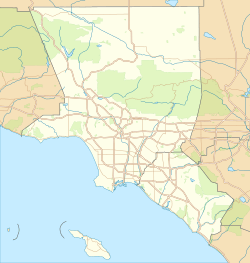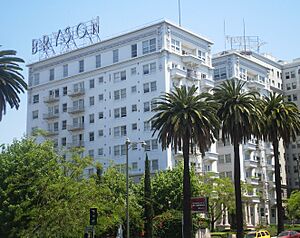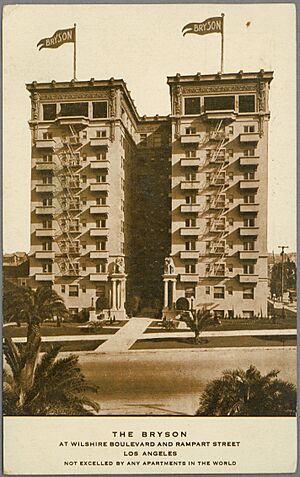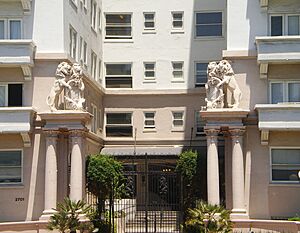Bryson Apartment Hotel facts for kids
The Bryson Apartment Hotel is a historic, ten-story apartment building located on Wilshire Boulevard in the MacArthur Park area of Los Angeles, California. Built in 1913, it was designed in the beautiful Beaux Arts style. For many years, it was known as one of the most fancy and luxurious places to live in Los Angeles.
This building is also famous for its connection to detective stories and movies. It appeared in books by Raymond Chandler and the 1990 movie The Grifters. The building's stone lions at the entrance and its big "Bryson" sign on the roof are well-known landmarks in Los Angeles. The Bryson Apartment Hotel was added to the National Register of Historic Places in 1983. It was also named a Historic Cultural Monument (#653) by the Los Angeles Cultural Heritage Commission in 1998.
|
Bryson Apartment Hotel
|
|
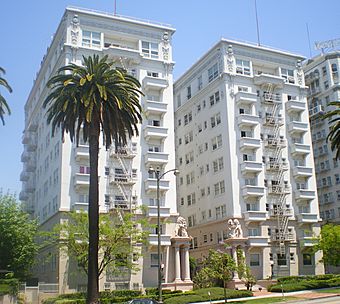
Bryson Apartment Hotel, Spring 2008
|
|
| Location | 2701 Wilshire Blvd., Los Angeles, California |
|---|---|
| Built | 1913 |
| Architect | Frederick Noonan & Charles H. Kysor |
| Architectural style | Classical Revival, Beaux Arts |
| NRHP reference No. | 83001184 |
Quick facts for kids Significant dates |
|
| Added to NRHP | April 7, 1983 |
Contents
Building the Bryson Apartment Hotel
The Bryson Apartment Hotel was built in 1913 by a real estate developer named Hugh W. Bryson. He chose a spot on Wilshire Boulevard, which at the time was mostly a residential area. Bryson bought and removed four houses that were on the land in 1911.
He first planned to build a six-story building close to the sidewalks. However, his neighbors were not happy with this idea. So, Bryson changed his plans. He decided to build a taller building, but set it back 100 feet (about 30 meters) from the street. In March 1912, Bryson announced his new vision. He wanted to create an apartment building that would be truly special. He said it would be "finer than any other west of New York City."
Bryson hired architects Frederick Noonan and Charles H. Kysor to design the building. His own company, F.C. Engstrum & Co., handled the construction. The building was finished very quickly, in just seven months, from June to December 1912. The total cost, including the land, construction, and furniture, was about $750,000. This was a very large sum of money back then!
Design and Features
The Bryson building combines two beautiful styles: Beaux Arts and Classical. It was built around a central courtyard that was 26 feet (about 8 meters) wide and 50 feet (about 15 meters) deep. When it first opened, the building had 320 rooms. These rooms were divided into 96 apartments. You could even connect apartments to make bigger suites with up to 12 rooms.
Every side of the building looked finished and beautiful. They were decorated with colorful tiles and concrete designs. Inside, the building was very fancy. It had cut-glass chandeliers, stairs and walls made of Italian marble, tile floors, and rich mahogany furniture.
The top floor was a common area for everyone living there. It had a ballroom, a library, a billiard room, and three enclosed loggias (open-sided rooms). Bryson spent a lot of money, about $60,000, on rugs, fine art, rare plants, and furniture for this top floor. Because the building was on a high spot and was the only tall building nearby, the top floors offered amazing views. A brochure from the 1920s described the view:
- "It has three large loggias from which one can see the Pacific Ocean."
- "Catalina Island 67 miles (108 km) away, on a clear day."
- "Green foothills, orange groves and snow-capped mountains."
Because The Bryson was set back 100 feet (about 30 meters) from the street, it had space for tennis courts and a large lawn and gardens. Even though the streets were made wider later, reducing some of the garden space, the landscaping was always a big part of its charm.
Life at the Bryson Apartment Hotel
Early Popularity
When The Bryson opened in January 1913, people loved it. The Los Angeles Times newspaper called it "magnificent." They said it was "probably the finest apartment-house west of New York City." Some people had thought Los Angeles was too small for such a grand building. But The Bryson was a huge success! In fact, every apartment was rented within two days of opening.
In 1915, the building was sold for $1.25 million. This was almost 70% more than it cost to build just three years earlier. In its early years, The Bryson was a popular place for famous and wealthy people. For many years, it was the only tall building and the most important landmark on Wilshire Boulevard. Other famous buildings like the Ambassador Hotel and Bullocks Wilshire were built later.
Connection to Raymond Chandler and Movies
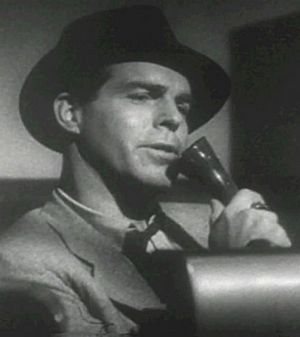
The Bryson became even more famous because of novelist Raymond Chandler. He featured it in his 1943 book The Lady in the Lake. Because of this connection, The Bryson is seen as one of the "faded palaces of L.A. noir." These were once grand buildings that became part of the city's mysterious detective stories. In the novel, detective Philip Marlowe visits the Bryson Tower while looking for a character.
Chandler described The Bryson as a "white stucco palace" with fancy lanterns and tall palm trees. He mentioned its marble steps, Moorish archway, and a very large lobby. Many fans of Raymond Chandler travel to Los Angeles to see the places from his books, including The Bryson. Its rooftop sign is seen as a symbol of old Los Angeles, just as Philip Marlowe would have seen it.
Chandler also used The Bryson as a setting when he helped write the movie script for the 1944 detective film Double Indemnity. This movie starred Fred MacMurray. Later, when director Stephen Frears made his 1990 movie The Grifters, he chose The Bryson Apartments as a main filming location. It was the home of a main character and the place where a very dramatic scene happened.
Later Years
In 1944, shortly after starring in Double Indemnity, actor Fred MacMurray bought The Bryson for $600,000. He owned the building for about 30 years. By the late 1940s, as other parts of Los Angeles grew, The Bryson started to lose some of its top-tier reputation. In 1949, MacMurray even got a reduction in his property taxes. He argued that the building was becoming too expensive to run.
By the 1970s, newer, flashier places in other parts of the city became more popular. The Bryson was no longer the most glamorous spot. In 1977, the Los Angeles Times reported that the 10th floor, which used to be the building's showplace, was now just used for storage.
In 1999, the building had a big renovation project that cost $5.5 million. During this work, the building's famous lion statues at the entrance were dressed in hard hats and orange construction vests. This drew a lot of attention and became a fun talking point for people passing by on Wilshire Boulevard.
Historic Status
The Bryson Apartment Hotel was added to the National Register of Historic Places in 1983. It was also named a Historic Cultural Monument (HCM #653) by the Los Angeles Cultural Heritage Commission in 1998. It is one of several historic places around Lafayette Park. Other nearby historic buildings include the Granada Shoppes and Studios, The Town House, the Felipe de Neve Branch Library, and Bullocks Wilshire.


